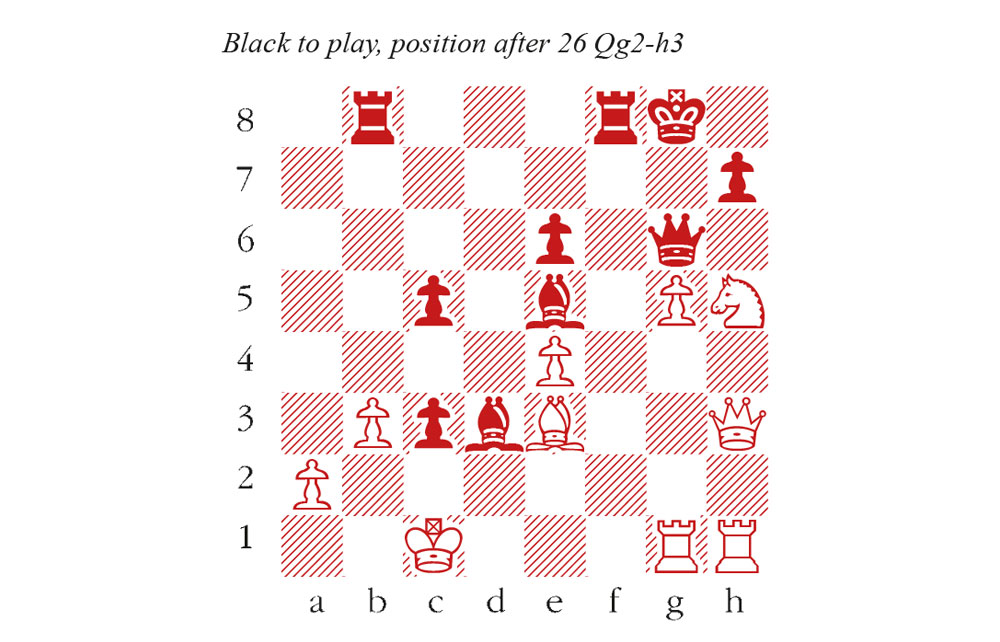The top Emirati grandmaster Salem Saleh is an imaginative, dynamic player whose games are a treat to watch. But his win at the recent Sharjah Masters against Vladimir Fedoseev (formerly Russian, but now representing Slovenia) was surely the artistic highlight of his career. The combination which ends the game is dazzling, but both players deserve credit for energetic play in the earlier part of the middlegame.
Vladimir Fedoseev-Salem Saleh
Sharjah Masters, May 2024
1 d4 Nf6 2 c4 g6 3 h4 A modern extravagance, mainly used by players who wish to avoid the combative Grünfeld defence which would arise after 3.Nc3 d5. If Black stubbornly insists on a Grünfeld-style approach with 3… Bg7 4.Nc3 d5, then 5.h5 poses serious problems. d6 4 Nc3 Nbd7 5 Qc2 c5 6 d5 a6 7 e4 b5 A standard pawn sacrifice borrowed from the Benko Gambit. For the sacrificed pawn, Black gets open lines on the queenside, and weakens White’s central grip. 8 cxb5 Bg7 9 bxa6 O-O 10 h5 An ambitious counter sacrifice, opening the h-file for an attack. Nxh5 11 g4 Nhf6 12 g5 Nh5 13 Be2 Bxa6 14 Bxh5 gxh5 15 f4 e6 A well-timed break. When the centre opens up, White’s king will be in danger too, but castling queenside will invite different problems. 16 Nge2 16 Qh2 is too primitive. After 16…Re8 17 Qxh5 Nf8 the attack reaches a dead-end. Qe8 17 dxe6 fxe6 18 Ng3 Ne5 I suspect this brilliant sacrifice was made primarily on intuitive grounds, since it animates the Bg7 and Rf8. A slower plan with 18…c4 and Nd7-c5-d3 was possible, but then the Ba6 loses some potency. In sharp positions, vigour takes priority over bean-counting. 19 fxe5 Bxe5 20 Qg2 20 Nxh5 meets with a beautiful refutation: 20…Qxh5! 21 Rxh5 Rf1+ 22 Kd2 Bf4 mate. Rb8 21 Nxh5 Qg6 22 Be3 d5 A clever idea, since 23 exd5 Bxc3+ 24 bxc3 Rb1+ wins quickly. 23 Bxc5 is viable, but then 23…Bxc3+ 24 bxc3 Rb2! attempts to deflect the queen from e4, and after 25 Qg4 Re2+ 26 Qxe2 Bxe2 27 Kxe2 Qxe4+ Black can count on at least a draw. 23 O-O-O d4 24 Rdg1 24 Qh3! was stronger, setting up the idea of Nf6+. After 24…dxc3 25 b3 Be2 26 Nf6+ Bxf6 27 gxf6 Bg4 the position remains wildly unclear. dxc3 The apparent drawback of 24…dxe3 is that White can immediately respond with 25 Nf6+, but after 25…Rxf6 26 gxf6 Qxg2 27 Rxg2+ Kf7 28 Rxh7+ Kf6 Black’s active bishops offer excellent compensation. 25 b3 Bd3 26 Qh3 (see diagram) Now was the time to jump in with 26 Nf6+!, since after Bxf6 27 gxf6 Qxg2 28 Rxg2+ Kf7 29 e5 White has the better chances. I suspect Fedoseev felt he could push for a knockout, but underestimated the ferocious counterattack which follows. Rxb3!! 27 axb3 Ra8 28 Kd1 Fedoseev must have overlooked the combination which follows, or he would surely have tried 28 Nf6+! After 28…Bxf6 29 Qxe6+ Kh8 30 Rxh7+ secures at least a draw, while after 29…Qf7 30 gxf6+ Kh8 31 Qc8+! is a stunning defensive resource, to distract the Ra8 from the mate threat on a1. However, after 31…Rxc8 32 Rg7 Qxg7 33 fxg7+ Kg8! 34 Rd1 Bxe4 35 Bg5 Kxg7 Black should probably win in the end. Qxh5+ An exquisite finish. The knight was guarding the f4 square. 29 Qxh5 Ra1+ 30 Bc1 Rxc1+ White resigns since 31 Kxc1 Bf4+ 32 Kd1 c2+ 33 Ke1 c1=Q+ 34 Kf2 Qe3+ 35 Kg2 Qg3 is mate.






Comments